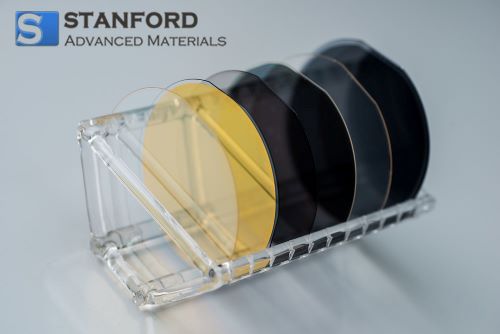Lithium Compounds In The Semiconductor Industry
Introduction
Lithium compounds are increasingly used in the semiconductor industry because their measured physical, chemical and electrical properties meet strict technical standards. These compounds, specifically Lithium Niobate (LiNbO₃) and Lithium Tantalate (LiTaO₃), are employed in optoelectronics, telecommunications and semiconductor components. The following sections detail the principal lithium compounds, their properties and their applications.
 [1]
[1]
1. Lithium Niobate (LiNbO₃)
Lithium Niobate is a well-documented material in lithium-based semiconductor applications. It exhibits electro-optic, piezoelectric and nonlinear optical properties. Given that it changes its refractive index when subjected to an electric field, it is used in optical modulators. It is also employed in surface acoustic wave (SAW) devices in mobile telephones and radio frequency systems. Its nonlinear optical properties enable frequency doubling by converting light wavelengths.

Key properties of LiNbO₃ include:
- Electro-optic effect: Lithium Niobate changes its refractive index when an electric field is applied, thereby allowing its use in optical modulators.
- Piezoelectric properties: It is utilised in SAW devices that operate in mobile telephones and radio frequency systems.
- Nonlinear optical properties: It enables frequency doubling by converting light wavelengths.
The material is used for:
- Optical modulators: Deployed in telecommunications for high-speed data transmission.
- SAW filters: Utilised in wireless communication devices, including mobile telephones and GPS systems.
- Frequency doubling: Employed in laser technologies for applications such as microscopy and precision measurements.
2. Lithium Tantalate (LiTaO₃)
Like Lithium Niobate, Lithium Tantalate exhibits electro-optic and piezoelectric properties and is employed in similar applications.
Its advantages include a higher electro-optic coefficient and a greater piezoelectric response.
It also has improved thermal stability at elevated temperatures and lower optical losses in the infrared spectrum.
The material’s high electro-optic coefficient facilitates modulation in integrated optical circuits. It is used in frequency converters that change light frequency. It benefits from low optical losses and a high nonlinear coefficient. It is also employed in SAW devices in telecommunications. Thin-film capacitors are manufactured using its dielectric properties. Moreover, it is used in laser devices for frequency doubling and optical parametric oscillation.
3. Lithium Fluoride (LiF)
Lithium Fluoride is another lithium compound used in thin-film applications. It is commonly used as a buffer layer in organic light-emitting diodes (OLEDs) and other semiconductor components.
It features a large bandgap that permits transmission of ultraviolet (UV) light. Consequently, it is employed in ultraviolet optoelectronic devices.
This thin-film material finds application in:
- OLEDs: Serving as a buffer layer to improve efficiency and performance.
- Thin-film optoelectronics: Used in devices such as UV detectors and sensors.
4. Lithium Disilicate (Li₂Si₂O₅)
Lithium Disilicate is primarily used in glass-ceramic materials for semiconductor packaging. These materials are chosen for their mechanical strength and thermal shock resistance.
The applications in semiconductor packaging include:
- Semiconductor packaging: Used to protect and electrically isolate semiconductor components.
- High-strength ceramics: Employed in mechanical components in modern electronics requiring high stability.
5. Lithium Sulphide (Li₂S)
Lithium compounds are also used in batteries. Lithium Sulphide is an emerging material for the development of solid-state batteries.
It offers efficient energy storage with high ionic conductivity. It is compatible with high-energy cathodes, thereby improving overall battery efficiency.
- High ionic conductivity: Lithium Sulphide exhibits excellent ionic movement.
- Compatibility with high-energy cathodes: This property enhances battery performance.
6. Lithium Phosphate (Li₃PO₄)
Lithium Phosphates are used in the development of thin-film lithium-ion batteries that are integrated into microelectronic devices and semiconductor systems.
Li₃PO₄ is utilised in:
- Thin-film batteries: Employed in microchips and small electronic devices requiring a compact power supply.
- Wearable devices and sensors: Integrated to provide energy storage in sensors and wearable electronics.
Conclusion
Lithium compounds are essential to the progress of modern semiconductor technologies. Lithium Niobate and Lithium Tantalate serve key roles in optoelectronics and telecommunications. Given the increased demand for efficient and scalable semiconductor solutions, lithium compounds will continue to impact electronics, communications and energy storage systems.
|
Lithium Compound |
Key Features |
Applications |
|
- Strong electro-optic effect |
- Optical modulators |
|
|
- Wide transparency range |
- Optical modulators |
|
|
Lithium Fluoride (LiF) |
- Large bandgap |
- OLEDs |
|
Lithium Disilicate (Li₂Si₂O₅) |
- High mechanical strength |
- Semiconductor packaging |
|
Lithium Sulphide (Li₂S) |
- High ionic conductivity |
- Solid-state batteries |
|
Lithium Phosphate (Li₃PO₄) |
- High energy density |
- Thin-film batteries |
Further information and products are available at Stanford Advanced Materials (SAM).
Reference:
[1] Wang, C., Li, Z., Riemensberger, J. et al. Lithium Tantalate Photonic Integrated Circuits for Volume Manufacturing. Nature 629, 784–790 (2024). https://doi.org/10.1038/s41586-024-07369-1

 Bars
Bars
 Beads & Spheres
Beads & Spheres
 Bolts & Nuts
Bolts & Nuts
 Crucibles
Crucibles
 Discs
Discs
 Fibers & Fabrics
Fibers & Fabrics
 Films
Films
 Flake
Flake
 Foams
Foams
 Foil
Foil
 Granules
Granules
 Honeycombs
Honeycombs
 Ink
Ink
 Laminate
Laminate
 Lumps
Lumps
 Meshes
Meshes
 Metallised Film
Metallised Film
 Plate
Plate
 Powders
Powders
 Rod
Rod
 Sheets
Sheets
 Single Crystals
Single Crystals
 Sputtering Target
Sputtering Target
 Tubes
Tubes
 Washer
Washer
 Wires
Wires
 Converters & Calculators
Converters & Calculators
 Chin Trento
Chin Trento



